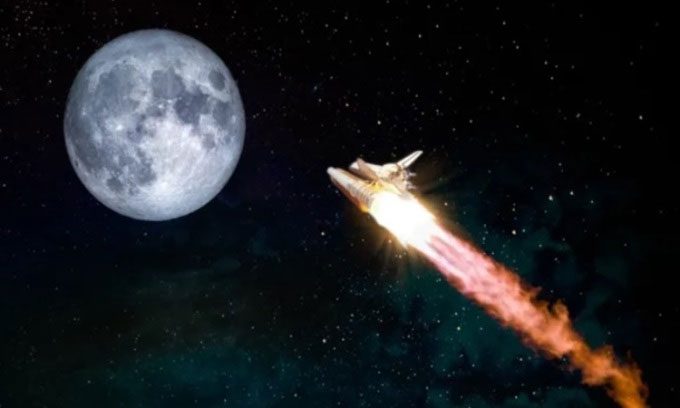The travel time from Earth to the Moon depends on various factors, including fuel amount, the Moon’s orbit, and the mission objectives.
Flying to the Moon is no easy task. This natural satellite orbits Earth at an average distance of 384,400 kilometers. Based on lunar missions over the past several decades, the travel time ranges from approximately 8 hours to 4.5 months. The fastest spacecraft to fly past the Moon was NASA’s New Horizons probe, launched in 2006 to study Pluto. New Horizons passed the Moon about 8 hours and 35 minutes after launch, according to Live Science.

Spacecraft can travel to the Moon in 8 hours – 4.5 months depending on various factors. (Image: Elen11).
However, for missions destined for the Moon, the journey is often longer. In 1959, during humanity’s first lunar mission, the Soviet Luna 1 spacecraft took 34 hours to reach its destination. This unmanned mission aimed to collide with the lunar surface, but the spacecraft veered off course, flying over 5,995 kilometers beyond the Moon. Eventually, the craft stopped transmitting signals when its battery ran out, and it continues to drift in space to this day. In 1969, when astronauts landed on the Moon, the Apollo 11 crew took 109 hours and 42 minutes from launch until Neil Armstrong took his first step onto the celestial body.
The travel time to the Moon varies significantly due to multiple factors, one of the most important being the amount of fuel used. Engineers have found that using less fuel for the flight to the Moon can result in a longer travel time, but the mission can still be completed by leveraging the natural gravitational pull of celestial bodies like Earth, which helps guide the spacecraft along a longer trajectory.
For example, in 2019, Israel sent an unmanned spacecraft named Beresheet to land on the Moon. After launch, Beresheet orbited Earth for about 6 weeks on an increasingly wide trajectory before gaining enough momentum to fly to the Moon. The spacecraft reached its destination, albeit not according to the predictions of the Israeli space agency. The team lost contact, and Beresheet crashed onto the lunar surface 48 days after launch, causing thousands of tardigrades to spill during the process.
The spacecraft holding the record for the longest flight to the Moon is NASA’s CAPSTONE probe. This 25-kilogram cubesat took 4.5 months to leave Earth, orbiting the planet several times before entering lunar orbit in 2022. CAPSTONE (Cislunar Autonomous Positioning System Technology Operations and Navigation Experiment) was sent to the Moon to test the orbit that NASA plans to use for the Gateway space station.
No matter which trajectory the spacecraft follows, each mission to the Moon undergoes several steps. Fuel constitutes 60-90% of the launch weight of any space mission, necessary for it to escape Earth’s gravity and advance into space. Once the spacecraft reaches orbit, it must use as little fuel as possible to achieve the optimal flight path to the destination, as carrying more fuel means the spacecraft is heavier and more costly. Ultimately, the spacecraft needs to execute a burn to escape Earth’s orbit.
Travel time to the Moon also depends on many other factors. According to Mark Blanton, who oversees analysis and evaluation for NASA’s Moon to Mars missions, one of the major factors is the mission’s objectives. “The space agency will assess the type of rockets available and their ability to propel the spacecraft. The capabilities of the rocket and the mission’s objectives will determine the size of the craft. After identifying all the requirements, experts will design the optimal trajectory.”
Everything related to the spacecraft and the flight, including accurately calculating the size of the craft, crew size, fuel allocation, and all other details, can impact the total travel time to the Moon.


















































